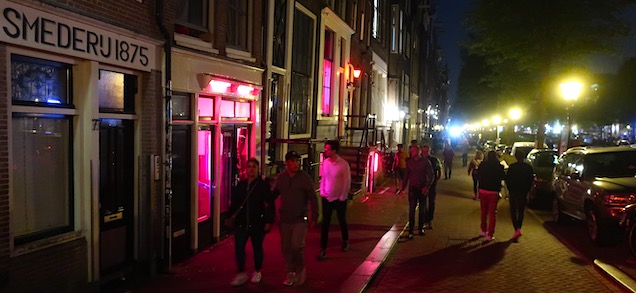
De Wallen Amsterdam
De Wallen District In Amsterdam
De Wallen – worldwide known as Amsterdam Red Light District – is a residential and entertainment area in the historical centre of Amsterdam, the city’s oldest part.

Amsterdam’s oldest canal.
The area is almost completely made up out of old historical buildings. Some of them dating back to the 16th or 17th century. The oldest building in the city – the Oude Kerk – even dates back to the year 1300. De Wallen is located next to the Central Station and is considered to be the entrance of Amsterdam.

The Oudezijds Achterburgwal, also known as the famous street of the Red Light District.
In total 4,550 people live in De Wallen. People from all parts of society live here. All surrounded by sex shops, red light windows, coffeeshops (cannabis stores), sex shows, historical and religious buildings and much more.
De Wallen represents the openminded-ness of the Dutch. Only here one can find an active church encircled by many window brothels.

The most narrow alley in Amsterdam.
De Wallen Translation
A literal translation of De Wallen is: Embankment.
De Wallen Meaning
Here’s a quote of an Amsterdam archeologist and professor Jerzy Gawronski in the Red Light District tour app explaining what De Wallen actually means:
The word ‘Wallen’ comes from the canals that cross section the Red Light District; the Oudezijds Voorburgwal and the Oudezijds Achterburgwal. A ‘burgwal’ means ‘defensive wall’ with a canal in front, but now the name is used for the canals itself, which were dug as a defense for Amsterdam. That’s why the whole neighborhood is now called “De Wallen” in Dutch.

Amsterdam, De Wallen, Oudezijds Achterburgwal.
Size Of De Wallen Amsterdam
Despite what many people might think about De Wallen area – also known as Red Light District – it isn’t really that big. The total size of de Wallen is 1 km2. The prostitution area itself measures around 250 meters by 250 meters.
The area borders on de Lange Niezel en Korte Niezel streets in the northern part. The Zeedijk and Nieuwmarkt in the eastern part, the Koestraat and Sint Jansstraat in the South and the Warmoesstraat. in the west.

The Warmoesstraat in De Wallen.
De Wallen Map
Outlined in red are the borders this area. As you can see Amsterdam Central Station is located on top of it. From Schiphol Airport by train you can be in area within 25 minutes.
De Wallen District Windows
Window brothel prostitution takes place in De Wallen area in the following streets:
✦ Barndesteeg
✦ Bethlehemsteeg
✦ Bloedstraat
✦ Boomsteeg
✦ Dollebegijnensteeg
✦ Enge Kerksteeg
✦ Gordijnensteeg
✦ Monnikenstraat
✦ Molensteeg
✦ Oudekerksplein
✦ Oudezijds Achterburgwal
✦ Oudezijds Voorburgwal
✦ Oudekennissteeg
✦ Sint Annendwarsstraat
✦ Sint Annenstraat
✦ Stoofsteeg
✦ Trompetterssteeg

A map of all window brothels on De Wallen in 2017.
Amsterdam Red Light District (De Wallen) has currently 201 window brothels which are rented in the daytime and nighttime.
More Info: Window Brothel Map

Amsterdam, Oudekennissteeg.
Sex in De Wallen
The red light windows on the Red Light District are there for a reason. Sex. Legal la prostitution. Here anyone from the age of 18 can legally have sex with a prostitute. Provided that the sex worker also wants this, of course.
Do you want sex in the Red Light District with a window prostitute? Then it is best to go to the relevant window brothel and approach the sex worker in a friendly manner. If she is available, she will open the door a crack and ask about your wishes. Once she accepts this, she can let you into the small brothel. Follow the etiquette and Wallen rules and be respectful. This enhances the experience for both.
Would you like to have sex at De Wallen, but rather not with a prostitute? Then consider using the popular sex date sites & apps in Holland. Here you will find like-minded people who are looking for someone who wants sex, without a relationship. Register now, make direct contact and who knows, you might find someone near you at De Wallen.
How much does a window in De Wallen cost?
A window brothel at De Wallen costs between 80 and 180 euros. The exact price depends on the day, time and exact location. A prostitution window is cheaper during the day than at night. Also, the best windows in the best locations are more expensive than outlying windows.
Why red lights in De Wallen?
What’s the deal with all the red lights in De Wallen? Many people wonder why this is such a common sight in prostitution. There are actually a few reasons for it! One reason is that it helps to hide imperfections. Red light is very forgiving, and it can help to disguise any blemishes or flaws in the skin. This is why many prostitutes choose to use red lights. Another reason is that red has represented the color of love for centuries.
Where can I find hookers in Amsterdam?
Sex workers in Amsterdam can be found in different ways, namely:
✦ In window brothels on De Wallen, Ruysdaelskade & The Singel area + Spuistraat
✦ Sex clubs & private sex houses
✦ Brothels
✦ Home prostitutes
Entertainment In De Wallen
The area also offers many other forms of other erotic entertainment. These include many sex shops, stripbars and erotic theatres. Moulin Rouge Amsterdam, 5D Porn Cinema and the Peep Show are the best sex shows in De Wallen area. Moulin Rouge tickets are exclusively available on website. De Wallen also has many bars and coffeeshops.
For those looking for more cultural experience de Wallen also has Ons’ Lieve Heer Op Solder Museum. The Hash Marihuana & Hemp Museum. The Museum Of Prostitution and changing expositions in Amsterdam’s oldest building; The Old Church.
15 ATTRACTIONS IN DE WALLEN >

What a window worker sees.
De Wallen Opening Hours
De Wallen is always open as it is a residential and public area in Amsterdam’s city centre.

Sint Annendwarsstraat in De Wallen.
Window Brothels
The opening hours for window brothels are between 06:00 am & 09.00 am. The windows are only closed for 3 hours a day. However depending on the time of day there might be more or less prostitutes working
The windows are rented in shifts; day shifts and night shifts. Most prostitutes prefer to take the night shifts because then there are more visitors in the Red Light District.
Bars and Restaurants

Cafe de Prael with its own beer brewery in the Oudezijds Armsteeg.
Restaurants et les cafés open and close spread out throughout the day. You can have breakfast starting from 8:00 am. Most restaurants close around 10:00 pm. The latest closing time for cafes and bars are 3:00 am from Sunday to Thursday. On Friday’s and Saturdays it’s 4:00 am.
Shops
Regular shops tend to open around 10:00 am and close around 7:00 pm.
Entertainment and erotic related shops tend to open around 10:00 am and close around 10:00 pm.

Amsterdam, Red Light District, Oudezijds Voorburgwal.
De Wallen Location
De Wallen is located in the heart of Amsterdam, just a short walk from the Central Station. The boundaries of De Wallen are officially between the Beursstraat, Nes, Nieuwmarkt, Zeedijk & Prins Hendrikkade. The area is bounded by canals, and its narrow streets are lined with cafes, bars, and shops.
The main streets in De Wallen are the Warmoesstraat, Oudezijds Voorburgwal, Oudezijds Achterburgwal and Zeedijk.
Navigate to the middle of De Wallen by using this address Oudezijds Achterburgwal 39-A in Google Maps.
De Wallen is best known for its window brothels, which are located on several of the area’s streets. However, there is much more to De Wallen than its red-light district. The area is also home to many museums and historical landmarks, making it a popular destination for tourists.
De Wallen Hotels
This area has a hotel for every taste. From the most luxurious 5 star hotel to the low cost bunkbed backpacker hotel.
Prices are seasonably bound so expect to pay more in the summer and less in low season. Low season in Amsterdam is between October and March, excluded the holidays in December. High season is between April and September.
On the following page you can find the best hotels in Amsterdam Red Light District. The overview offers both affordable and exclusive hotels.
Hotel Map
The top 10 hotels are listed in De Wallen map:
Minimum Age At De Wallen
Wondering how old you have to be for De Wallen? That’s simple! There is no minimum age to enter De Wallen. After all, it is a residential, shopping and entertainment area.
There is, however, a minimum age to visit the prostitutes, coffee shops and smart shops. You must be at least 18 years old for this.
Can you go to the Red Light District as a woman?
Yes, women are allowed in the Amsterdam Red Light District. In fact, it is one of the most popular tourist destinations for women in the city. While there are some areas that are off-limits to women, such as the windows where the prostitutes display themselves, there is still plenty to see and do in the district. Women can visit the many sex shops, brothels, and museums, or simply enjoy the lively atmosphere. Of course, it is important to be aware of your surroundings and not to stray into any areas that may be dangerous. But overall, the Amsterdam Red Light District is a safe and interesting place for women to visit.
De Wallen Amsterdam History

Amsterdam’s Red Light District in 1983. A sex worker talks with a (potential) customer.
De Wallen area is the oldest part of Amsterdam. Both the above mentioned Oude Kerk and the Warmoesstraat situated next to it date back as far as the 13th century. In the 15th century or even before that prostitution was taking place in De Wallen area. Perhaps not on the exact streets that are the places for it today.

Amsterdam’s Red Light District in 1905 with two prostitutes.
But ever since the 15th century prostitution hasn’t left this part of town. There’s a historical record of brothels and other prostitution establishment being located in the Oudezijds area. Also often also in other parts of the city.

The most narrow alley in Amsterdam, 1969.
Prostitution in Amsterdam has often been banned from 1578 and onwards. Those people who did it or facilitated it were sanctioned and driven away from the city. Window brothel prostitution made its first appearance in the 1930’s. Prostitutes were forbidden from soliciting men from their doorway by the police. Sitting behind a window with a tiny split in the curtains was allowed.

Amsterdam in 1969. A prostitute is waiting for customers while a couple walks by.
In the 1960’s – during the sexual revolution – the modern iteration of the Red Light District really started. In that era prostitution increased significantly in the area. More window brothels and and more sex shops were opened.
More pictures and details: De Wallen History

Amsterdam’s Oudekerksplein (Old Church Square) with a daycare and window brothels.
Change in De Wallen of Amsterdam
In the summer of 2007, the Coalition Project 1012 (in short Project 1012) was initiated. Together the municipality and the centre district of Amsterdam started working on creating more variety and reducing crime. And also to economically upgrade the zip code area 1012, which is also the zip code of De Wallen.

The Upcycle Store is part of gentrification-plan called Project 1012.
In 2009, the city council agreed to designate window prostitution as a criminal sector. In 2011, the city council decided to expel the window brothels from, for example, Sint Annenstraat and Oudekerksplein and the surrounding area. All located in the same area. The municipality expected to help women who were forced into prostitution.
The building above used to have several window brothels. The building was bought by the City of Amsterdam which rents it to an entrepreneur who offers recycled products in the Red Light District. This company is hardly visited, because people do not visit this neighborhood for these types of products.

Amsterdam, Red Light District, Sint Annenstraat.
Amsterdam Project 1012 Failed
In 2018, the Amsterdam Court of Audit found that the government’s Red Light District project had not been successful. Despite the closure of 112 window brothels and 48 coffeeshops. And almost no crime related to this project was found 10 years in De Wallen. Some locals and experts claimed that the local government only used Project 1012 as an excuse to change this part of Amsterdam by decreasing prostitution and cannabis related businesses.
A LIRE AUSSI :
Prix du quartier rouge d'Amsterdam







